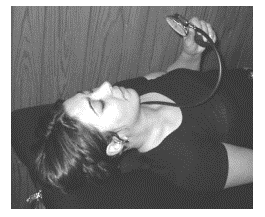Deep Neck Flexors (DNF) Need Work? ?Use a PBU!
Reference:The following is an extremely brief summary taken from the DNF protocol of The Whiplash Physical Diagnostic Clinic, Department of Physiotherapy, University of Queensland, Australia.
Many studies have now concluded that patients with cervical headaches or cervical pain following motor vehicle accidents have significant loss of their deep segmental cervical muscles.
These studies have all used the Pressure Biofeedback Unit (PBU) for the evaluation and retraining of the DNF.
Position the PBU in the sub-occipital region (not mid cervical) and inflate the PBU to 20mmHg
Instruct the patient to perform upper cervical flexion by SLOWLY nodding ?yes? to target 22mmHg and hold the position steadily for up to 10 seconds. If successful, progressively target 24, 26, 28 and to a maximum of 30mmHg
Ask patient to ?visualize? their DNF contractions
Correct performance: 1) Satisfactory performance is at least 26mmHg holding a steady contraction for 10 by 10 seconds
2) NO superficial muscle activity is present (i.e. no contraction of SCM or scaleni)
Poor Performance: 1) Phasic contraction of the superficial muscles (most common)
2) Too quick (much verbal feedback required to be slow)
3) Overshooting target / going too far
4) Patient retracts neck instead of pure upper cervical flexion
5) Patient attempts to lift head off the bed
Clinical Relevance: The greater over-activity present in the SCM and Scaleni muscles, the more this indicates poor segmental muscular control.
Personal Comment:If you are interested in a pressure biofeedback unit ($139), please contact: 905-707-0819.
A COMPLIMENTARY instructional video on DNF retraining is also included with the PBU (limited number available).
Posted on: October 30, 2002
Categories: Cervical Spine


